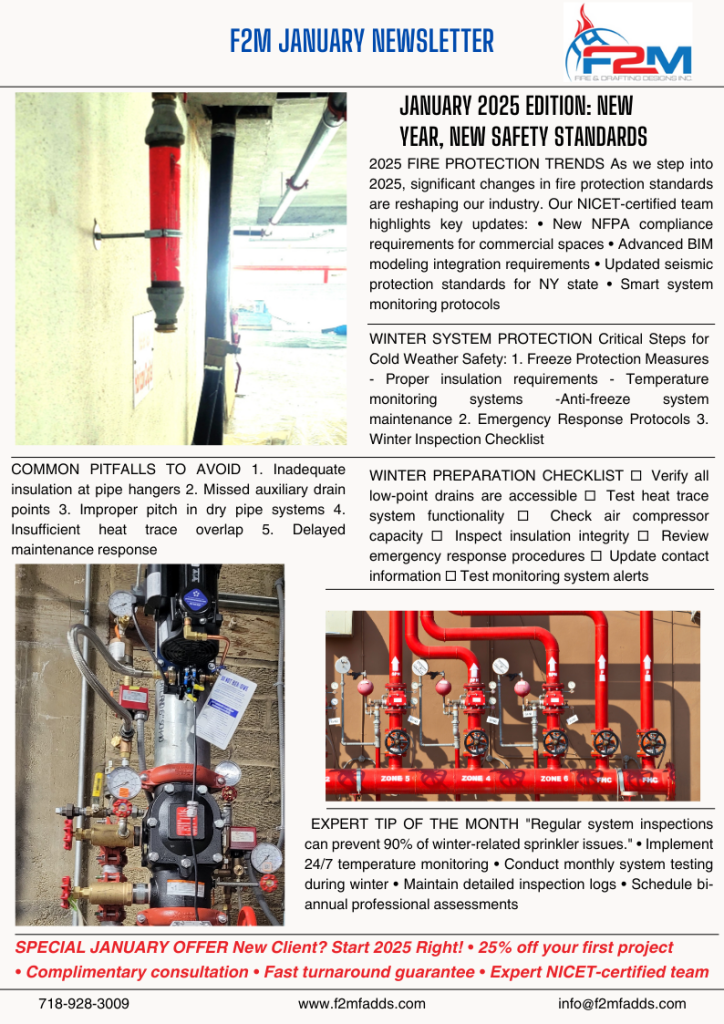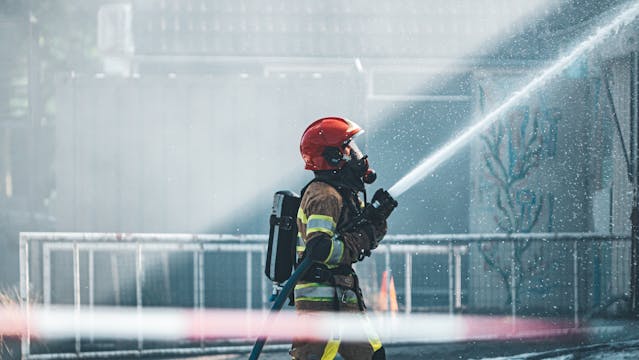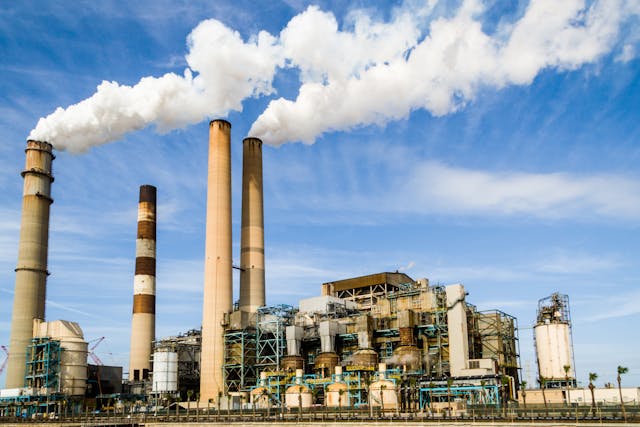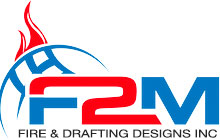Archive for January 2025
Fire Sprinkler Design & Maintenance Newsletter January 2025

Inspections for Fire Sprinkler Systems in New York: Make Sure Your System is Up To Code
This blog post will guide you through the steps to prepare for inspections of fire sprinkler systems in New York. Fire inspections are crucial for ensuring that your fire sprinkler system is up to code and capable of protecting lives and property in the event of a fire. In New York, compliance with fire safety regulations is mandatory, and failing to meet these standards can result in fines, legal liabilities, and increased risk of fire-related incidents.

Fire Inspections for Fire Sprinkler Systems in New York: Understanding New York Fire Codes
New York City Fire Code
The New York City Fire Code sets forth the fire safety requirements for buildings and properties within the city. Key elements include:
- Specific requirements for the design, installation, and maintenance of fire sprinkler systems.
- Regular inspection and testing protocols to ensure system functionality.
- Compliance with the latest National Fire Protection Association (NFPA) standards.
New York State Fire Code
Outside of New York City, the New York State Fire Code provides guidelines for fire safety. Key points include:
- Adoption of NFPA standards for fire sprinkler system design and maintenance.
- Regular inspections and testing to ensure compliance with state regulations.
- Specific requirements for different types of properties, such as residential, commercial, and industrial buildings.
Preparing for a Fire Inspection
Regular Maintenance and Inspections
Routine maintenance and inspections are essential to ensure your fire sprinkler system is always ready for a fire inspection. Best practices include:
- Conducting monthly visual inspections to check for any visible damage or obstructions to sprinkler heads and piping.
- Performing quarterly system checks, including testing alarm valves, pressure gauges, and control valves.
- Scheduling annual professional inspections and testing of the entire system by certified professionals.
Testing the System
Regular testing ensures that your fire sprinkler system will function correctly during an emergency. Key tests include:
- Flow Testing: Verifying that the water pressure and flow rate are adequate for effective fire suppression.
- Alarm Testing: Ensuring that the fire alarm system activates correctly when the sprinkler system is triggered.
- Functional Testing: Checking the operation of control valves, switches, and other system components.
Documentation and Record Keeping
Maintaining Records
Detailed records of all inspections, tests, and maintenance activities are crucial for compliance and future reference. Key steps include:
- Documenting all inspections and maintenance activities, including the date, findings, and actions taken.
- Maintaining records of any repairs or replacements performed on the system.
- Ensuring that records are easily accessible for regulatory inspections and audits.
Compliance with Regulations
Ensure that your documentation complies with local and state regulations. This includes keeping records for a specified period and providing them to fire inspectors upon request.
Training and Preparedness
Employee Training
Training employees on fire safety practices is essential for ensuring a swift and effective response during an emergency. Training should cover:
- Proper use of fire extinguishers and other fire-fighting equipment.
- Evacuation procedures and emergency exits.
- Recognizing and reporting potential fire hazards.
Conducting Fire Drills
Regular fire drills help familiarize employees with evacuation procedures and ensure they can respond quickly in an emergency. Best practices include:
- Scheduling fire drills at regular intervals to maintain preparedness.
- Evaluating the effectiveness of each drill and making necessary improvements.
- Incorporating feedback from employees to enhance fire safety measures.

Working with Fire Safety Professionals
Hiring Certified Inspectors
Certified fire safety professionals have the expertise to conduct thorough inspections and ensure compliance with all relevant codes. Benefits include:
- Identifying and addressing potential issues before they become significant problems.
- Ensuring that all system components are in proper working condition.
- Providing detailed reports and recommendations for improvements.
Partnering with Fire Protection Companies
Partnering with a reputable fire protection company can help ensure that your fire sprinkler system remains compliant and functional. Services include:
- Regular maintenance and inspections by experienced professionals.
- Expert guidance on compliance with local and state fire codes.
- Access to advanced fire protection technology and solutions.
Fire Inspections for Fire Sprinkler Systems in New York: Conclusion
Preparing for fire inspections in New York requires a thorough understanding of local and state fire codes, regular maintenance and testing, proper documentation, and employee training. By following these steps and working with certified professionals, you can ensure that your fire sprinkler system remains up to code and provides reliable protection for your property and occupants.
At F2M Fire & Drafting Designs Inc., we specialize in helping businesses prepare for fire inspections and maintain compliant fire sprinkler systems. Contact us today to schedule an inspection or learn more about our maintenance programs.
F2M Fire & Drafting Designs Inc.
31 South Street, Suite 3S-4
Mount Vernon, NY 10550
718-928-3009
Email: info@f2mfadds.com
Ensure your fire sprinkler system is up to code with our expert services and support.
Fire Sprinkler System Design for High-Risk Environments: Key Considerations
Fire sprinkler systems design for high-risk environments requires careful planning and specialized knowledge. These environments, which include industrial facilities, chemical plants, and data centers, present unique challenges that demand robust and reliable fire protection solutions. In this blog post, we will explore the key considerations for designing fire sprinkler systems in high-risk environments.

Understanding the Unique Risks
Identify Fire Hazards
The first step in designing an effective fire sprinkler system is to identify the specific fire hazards present in the environment. Consider:
- The types of materials and substances that could ignite, such as flammable liquids, chemicals, or electronic equipment.
- The processes and activities that could potentially cause a fire.
- The historical data on fire incidents within similar environments.
Assess Fire Load
Understanding the fire load, or the amount of combustible material present, is crucial for selecting the appropriate fire suppression system. High fire loads require systems that can deliver sufficient water or suppression agents to control or extinguish fires effectively.
Choosing the Right Fire Suppression System
Water-Based Systems
Water-based fire sprinkler systems are a common choice for many high-risk environments due to their reliability and effectiveness. Key options include:
- Wet Pipe Systems: Ideal for environments where freezing is not a concern, providing quick response to fires.
- Dry Pipe Systems: Suitable for areas prone to freezing, with pipes filled with pressurized air until activated.
- Deluge Systems: Designed for high-hazard areas, providing rapid and extensive water coverage when activated.
Foam-Based Systems
Foam-based fire suppression systems are effective for environments with flammable liquids and chemicals. Options include:
- Foam Sprinkler Systems: Combines water with foam concentrate to create a foam blanket that smothers the fire and prevents re-ignition.
- High-Expansion Foam Systems: Generates large volumes of foam to fill an entire room or area, ideal for enclosed spaces.
Gas-Based Systems
Gas-based fire suppression systems are suitable for environments with sensitive equipment and electronics. Options include:
- Inert Gas Systems: Uses gases like nitrogen and argon to displace oxygen and suppress fires without damaging equipment.
- Chemical Gas Systems: Uses agents like FM-200 or Novec 1230 to extinguish fires quickly and safely.
System Design and Layout
Customizing the Design
High-risk environments often require customized fire sprinkler system designs to address specific risks. Considerations include:
- Coverage: Ensuring all areas of the environment are adequately covered by the sprinkler system.
- Spacing: Proper spacing of sprinkler heads to ensure uniform water or agent distribution.
- Accessibility: Ensuring that sprinkler system components are accessible for maintenance and inspection.
Hydraulic Calculations
Accurate hydraulic calculations are essential to ensure the fire sprinkler system can deliver the required flow and pressure to control or extinguish a fire. Key factors include:
- Determining the required water or agent flow rate for the specific fire risk.
- Calculating pressure losses in the piping system to ensure adequate pressure at the sprinkler heads.
Compliance with Regulations
Meeting Safety Codes
Compliance with local, state, and national fire safety codes is critical for the design and installation of fire sprinkler systems in high-risk environments. Key standards include:
- National Fire Protection Association (NFPA) standards, such as NFPA 13 for sprinkler systems and NFPA 16 for foam systems.
- Local building and fire codes specific to the environment and industry.
Regular Inspections and Maintenance
High-risk environments require regular inspections and maintenance to ensure the fire sprinkler system remains operational. Best practices include:
- Monthly visual inspections of system components.
- Quarterly checks of alarm systems and control valves.
- Annual professional inspections and testing of the entire system.
Fire Sprinkler System Design for High-Risk Environments: Conclusion
Designing fire sprinkler systems for high-risk environments requires a thorough understanding of the unique risks, careful selection of the appropriate suppression system, and meticulous planning of the system layout. By considering these key factors, you can ensure that your fire sprinkler system provides reliable and effective protection for your high-risk environment.
At F2M Fire & Drafting Designs Inc., we specialize in designing and installing fire sprinkler systems for high-risk environments. Contact us today to discuss your specific fire protection needs and find the best solution for your facility.
F2M Fire & Drafting Designs Inc.
31 South Street, Suite 3S-4
Mount Vernon, NY 10550
(718) 928-3009
Email: info@f2mfadds.com
https://www.f2mfadds.com/contact
Let our experts help you design a fire sprinkler system that provides robust and reliable protection for your high-risk environment.
